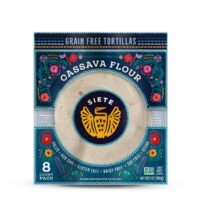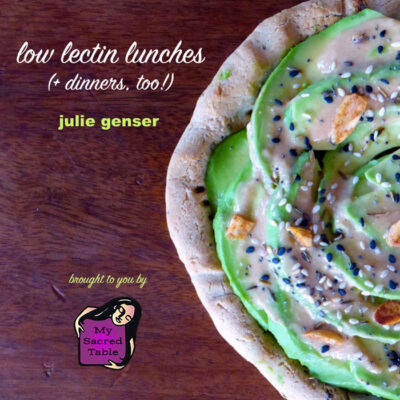Dry Heating – Dry heating methods that use air or fat to cook food, like broiling, roasting, grilling, baking, sauteing, pan-frying and deep-fat frying, will not reduce lectin content of foods.
Fermenting – Fermentation is a method of food preparation that converts carbohydrates to alcohol or organic acids using bacteria or yeasts under anaerobic conditions. The microorganisms break down lectins which means many fermented foods are safe for a low lectin diet, including fermented soy products like miso, tempeh and natto, plus fermented vegetables like cabbage, carrots, beets, and ginger, and cheeses, kefir, and yogurt. Fermented foods are packed with probiotics, which are the beneficial bacteria required for a healthy microbiome.
Food Dehydrator – A food dehydrator uses a heat source and fan to reduce the moisture content of food while preserving nutrients. Removing water from food keeps microorganisms from growing and reduces food spoilage, extending the shelf life of the food. Food dehydration is popular with raw foodists. Dehydrating temperatures for food to still qualify as raw are typically between 105 degrees Fahrenheit (41° C) and 115 degrees Fahrenheit (46° C), as temperatures above 118 degrees Fahrenheit will start to degrade the nutrient value of the food.
Dr. Steven R. Gundry – Former cardiac surgeon and author of the best-selling book The Plant Paradox which outlines his popular low lectin diet and explains the long-term dangers of ingesting harmful lectins. visit his website
Lectins – Lectins are small glycoproteins that are naturally found in most plants as part of their defense system against plant predators. When animals eat plants, the lectins will end up in the animal. When humans eat plants and animals containing lectins, they can do harm in our bodies by attaching themselves to specific sugar molecules in our blood, intestinal lining, and on our nerves. There, they can cause leaky gut (literally creating microscopic holes in our gut lining) and activate an autoimmune response when our immune system identifies them as foreign invaders.
Neu5Gc – Neu5Gc is a sugar molecule found in red meat and organs, pork organs, and some dairy products that increases in concentration when cooked. Neu5Gc is naturally found on cell surfaces in most mammals and gets ingested into human cells when eaten. When it enters the human body, it activates an immune response, as the immune system will identify it as a foreign invader. Continual consumption of Neu5Gc will result in chronic inflammation, and a potential increase in the risk of tumor formation. Neu5Gc has been associated with cancer, cardiovascular and other inflammatory diseases, as well as some bacterial infections.
The Plant Paradox Diet – A popular low lectin diet developed by former cardiac surgeon Dr. Steven R. Gundry. The diet is outlined in his book The Plant Paradox: Hidden Dangers in “Healthy” Foods that cause Disease and Weight Gain.
Pressure Cooking – Pressure cooking is a method of wet heat cooking that uses water or other liquids in a sealed, high pressure cooking vessel. It approximates the effects of long braising but in a much shorter timeframe. Most foods that can be cooked in steam or water-based liquids can be cooked in a pressure cooker. Pressure-cooking is the best way to reduce lectins, especially combined with peeling, de-seeding, soaking and/or sprouting. You need a pressure cooker or InstaPot in order to pressure cook.
Resistant Starch – Starches are long chains of glucose found in many carbohydrates (potatoes, grains and more). Not all starch is digestible to humans, however. Resistant starch is starch that passes through the digestive tract undigested (e.g., ‘resistant’ to digestion), providing food for your beneficial gut bacteria and increasing the production of short-chain fatty acids like butyrate. Resistant starch acts like soluble, fermentable fiber and has many health benefits. It’s been shown to improve insulin sensitivity, lower blood sugar levels, reduce appetite and help digestion.
There are four types of resistant starch:
- Type 1: Resists digestion because it’s bound within the fibrous cell walls of plants. Found in grains, seeds and legumes.
- Type 2: Found in starchy foods like raw potatoes and green (unripe) bananas, papaya and mangoes.
- Type 3: Formed when certain starchy foods, like potatoes and rice, are cooked and then cooled. The act of cooling converts some of the digestible starches into resistant starches via retrogradation.
- Type 4: Formed via a chemical (man-made) process.
Certain foods can contain multiple types of resistant starch, and the method of food preparation will change the concentration of resistant starch. Food that contains resistant starch includes many root vegetables — cassava, sweet potato, celery root (celeriac), konjac root (Miracle Noodles), rutabaga, and turnips to name a few — and unripe fruits (full of highly fermentable prebiotic fiber) like green bananas, plantains, mangoes and papaya, as well as millet and sorgum, cooked and cooled rice, beans and legumes, and cooked and cooled potatoes.
Slow Cooking – Using a slow cooker, or crockpot, is a method of preparing foods that uses a low heat, tight-fitting lid to lock in moisture, and lengthier cooking times that is similar to traditional food preparation methods like braising, stewing, and Dutch oven cooking. It’s convenient, as you can prepare a crockpot meal in the morning and it will be ready by lunch or dinner. Note: Cooking lectin-containing foods in a slow cooker is not recommended, as the low temperature can actually increase the lectin concentration.
Soaking/Sprouting – Soaking and sprouting nuts, seeds, beans, and whole grains helps to break down the anti-nutrients (including phytic acid, lectins, gluten, tannins, and complex sugars) found in the outer skin or shell. To soak, items are placed in water up to 24 hours and then rinsed. Soaking times for these foods vary so it’s important to research that before beginning. Letting foods soak longer will result in sprouting but there is a risk of mold growth. Here is an article to learn more about soaking vs. sprouting.
Weston A. Price – Weston A. Price was a dentist and nutrition pioneer who researched the diets of traditional societies around the world and was able to determine the optimum characteristics of human diets. His research showed perfect inter-generational health when people consumed nutrient-dense whole foods and the fat-soluble activators found exclusively in animal fats. Learn more: visit the Weston A. Price Foundation website
Wet Heating – Wet heating methods that use use water, liquid or steam to transfer heat to foods include poaching, simmering, boiling, braising, stewing, pot roasting, steaming, en papillote, and pressure-cooking. While these will help to reduce lectin content of some foods, pressure-cooking is the best way to reduce lectin concentrations.





















Recent Raves